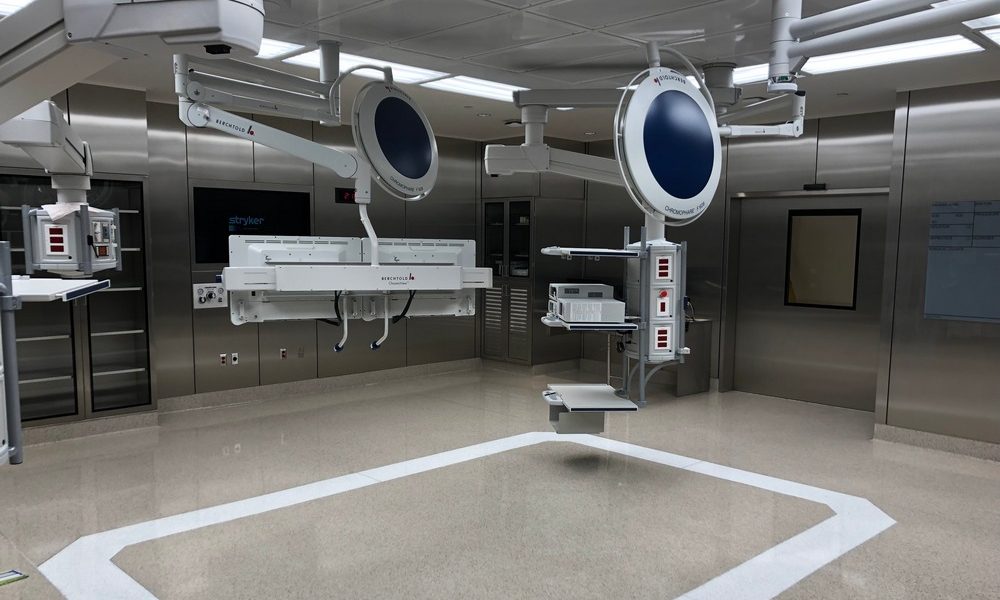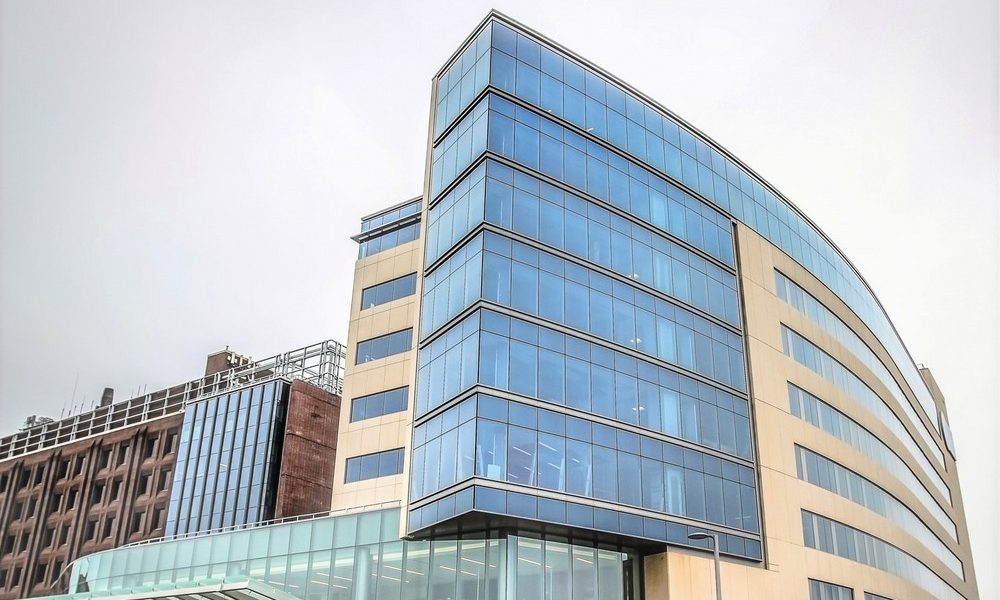 To meet the evolving changes of the healthcare industry, Skanska USA recently brought an integrated solution to accommodate future equipment and/or room set-up changes at Saint Francis Hospital in Tulsa, Oklahoma.
To meet the evolving changes of the healthcare industry, Skanska USA recently brought an integrated solution to accommodate future equipment and/or room set-up changes at Saint Francis Hospital in Tulsa, Oklahoma.  Skanska USA constructed the new Ambulatory Care Pavilion at Westchester Medical Center, Valhalla, New York, which established outpatient services previously unavailable on the campus. The local community now has access to an advanced imaging center, heart and vascular institute and ambulatory surgery center.
Skanska USA constructed the new Ambulatory Care Pavilion at Westchester Medical Center, Valhalla, New York, which established outpatient services previously unavailable on the campus. The local community now has access to an advanced imaging center, heart and vascular institute and ambulatory surgery center.
Subscribe Now
How COVID-19 is Reshaping Medical Facilities
By Jason Groshart
COVID-19 has accelerated our need to consider the next generation of healthcare and, particularly, how medical facilities are built and designed to better serve patients in both “normal times” and times of crisis, like today. The ability to provide sufficient care stems from our health professionals — who have remained steadfast on the front lines of the pandemic — but as our experience with COVID-19 has widely revealed, it also has much to do with the building and design of the facilities themselves.
Since the onset of the pandemic, healthcare organizations have been forced to make quick, if not real-time decisions, on how to best adapt their medical facilities to better prepare and respond to changing needs. From the influx of patients, to the ability to impose adequate distancing and safety measures, to continuing care for non-COVID-19 patients, healthcare organizations have had to address countless issues simultaneously. In response, new building and design tactics are being vetted at a rapid pace, such as the redesign of physical space, implementation of new technologies and infrastructural updates. While the pandemic served as the impetus for these changes, many will be here to stay.
New & innovative technology
To keep healthcare facilities future-proof, they must be designed with ever-evolving technology in mind. Technology has the power to make hospitals safer and more efficient. We are seeing a growing adoption of touchless technology throughout hospitals. Many are engineering out high touchpoints in facilities, such as computers, screens and hardware to get in and out of rooms, and instead implementing touchless technology. For instance, there is a growing focus on sink sensors, door sensors, virtual assistants such as Amazon Alexa in spaces — instead of nurse call buttons — and self-check in options from a smartphone or online.
As a result of the coronavirus, in particular, we are also seeing technology support better infection control, such as UV-C light disinfectant, sterilizing mists in public areas and temperature scanners at building entrances.
Flexible space
There is an immense, and growing, focus on flexibility within medical facilities. Scalability in patient room designs is important for resiliency planning and meeting specific needs during challenging times. While building flexible spaces may have higher upfront costs, it can also lead to greater bed utilization and better return on investment.
One strategy for flexible spaces includes modular solutions, such as prefabricated or ceiling systems easily adaptable for technology advancements. This modular operating room technology offers greater flexibility in medical equipment selection and reduces the time it takes for future operating room renovations or equipment upgrades. In addition, modular wall and system designs in waiting areas to section off different patient types is another way to leverage modularization to provide better protection in the healing environment. For instance, separating infectious disease-probable patients from trauma or routine care patients.
Private patient rooms that can easily be converted back to semi-private rooms to accommodate inpatient overflows is also important. There has been a big trend in healthcare over the past several years to incorporate all private patient rooms. This was tied to creating a better patient care environment. However, the COVID-19 pandemic shed light on the fact that our healthcare system was not prepared to handle a pandemic response effort and we ran out of bed space in the virus hot spots. Moving forward, a smarter strategy may be to equip private patient rooms that can be converted back to semi-private space if needed. So, from a construction standpoint, we can include additional med/gas headwall connections and construct them in a way that they are easier to access so they won’t require a significant retrofit if more bed space is needed in times of high-patient volume.
Finally, ambulatory surgery centers that can support inpatient needs in time of crisis are also an important part of a flexible space hospital strategy. Lesson learned from the COVID-19 pandemic showed that ambulatory spaces part of greater health systems were more ideal alternative care sites for caring for an influx of patients. This is due to already having imaging, support spaces and care providers already adapted to workflows in these spaces. If healthcare regulations allow, it is smarter to plan long term for these ambulatory spaces to be equipped to support inpatient needs for future waves/pandemics.
Separation of spaces
Just as flexible spaces are crucial, particularly in a time like today, so too is the ability to better separate spaces within a medical facility. COVID-19 has shown the increased need to separate patients, staff and guests to ensure the health and safety of everyone within a facility. Reworking lobbies and public spaces to decrease the amount of interactions between individuals moving about within hospitals is going to be vital.
A few examples of this include widening hallways and corridors, building separate entrances, building more anterooms and vestibules for donning and doffing PPE and installing more sinks in hallways outside of bathrooms. The ability to remotely monitor spaces, in order to create more separation and help reduce patient contact to limit staff exposure, can also facilitate appropriate separation of space.
HVAC needs
As we have come to find out, the COVID-19 virus primarily spreads person to person through respiratory droplets from coughing, sneezing or talking. In times like today, it is not safe to recirculate air and, as a result, we are seeing growing interest from medical facilities to have the ability to filter 100% outside air. With 100% outside air, it is important to note that additional cooling capacity is needed to cool the warmer air outside into the facility. An alternative strategy is enhancing the HVAC air cleaning technology with added filtration in air handlers. Regulations in California require robust filtration such as this in orthopedic operating rooms. It includes a series of three filter banks with MERV 8, 14 and 17 filters. This application could also be applied to pandemic response when filtration of recirculated air is critical. And depending on the filtration system, it can have energy savings resulting in a lower carbon footprint.
Outpatient centers
There is a growing trend in healthcare to move specialty practices, like pediatric and cancer centers, closer to residential areas. Due to their convenience, these centers would encourage people to make more routine visits and allow them to better stay on top of their health.
Major hospitals in California and across the country are greatly increasing their footprint by constructing small outpatient clinics in surrounding communities. This makes healthcare more accessible and convenient to their patients. It eliminates the need to go to a large medical center campus and the associated headaches that go with that, from sitting in traffic, to finding parking, to coming in contact with multiple other patients that is so prevalent today, with COVID-19.
By taking lessons learned from the pandemic paired with new, innovative thinking, the industry can implement dynamic and sustainable building and design strategies that can empower better care for patients and respond to changing medical needs now and into the future.
Author: Jason Groshart
Jason Groshart is vice president, Healthcare, Skanska USA.
Tags: Construction, COVID-19, Technology, Trends
Posted September 15, 2020
More Articles:
- CxA Workshop & Exam
Apr 29, 2024 – Apr 30, 2024 - EMP Seminar & Exam at CxEnergy 2024
Apr 29, 2024 – Apr 30, 2024 - CxEnergy
Apr 29, 2024 – May 2, 2024 - PHCC West 2024
Apr 29, 2024 – May 2, 2024 - Lean in Design Forum 2024
May 1, 2024 – May 2, 2024 - IFMA’s Facility Fusion Conference & Expo
May 5, 2024 – May 7, 2024 - ASHE Academy 2024
May 6, 2024 – May 10, 2024










